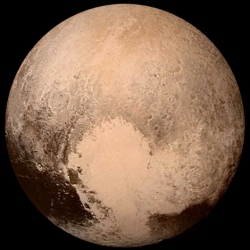
Pluto would appear to have glaciers of nitrogen ice, the latest pictures from the New Horizons probe suggest. Scientists believe they see evidence of surface material having flowed around mountains and even ponding in craters. The activity is certainly recent, they say, and may even be current.
But the mission team cautions that it has received only 4-5% of the data gathered during 14 July’s historic flyby of the dwarf planet, and any interpretations must carry caveats. "Pluto has a very complicated story to tell; Pluto has a very interesting history, and there is a lot of work we need to do to understand this very complicated place," said Alan Stern, the New Horizons principal investigator.
In a briefing at the US space agency’s HQ in Washington DC, he and colleagues then outlined a number of new analyses based on the limited data-set in their possession. These included the observation that Pluto has a much more rarified atmosphere than previously predicted by the models.
This statement comes from measurements made by the probe as it was looking back at Pluto following the flyby. It could tell from the passage of sunlight and radiowaves through the Plutonian "air" that the pressure was only about 10 microbars at the surface (1 microbar is about a millionth of the air pressure on Earth at sea level).
The other key detection was of hazes in the atmosphere. These are likely the consequence of high-up methane being broken apart and processed by sunlight into simple hydrocarbons like ethylene and acetylene, which then fall, cool and condense to form a mist of ice particles.
Some of this material will probably be further processed into more complex chemistry that rains on to the surface to give certain regions their characteristic reddish hue.
